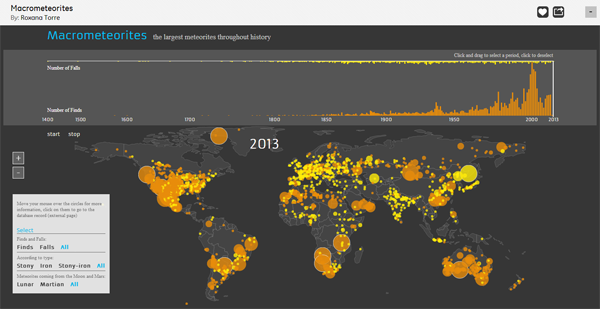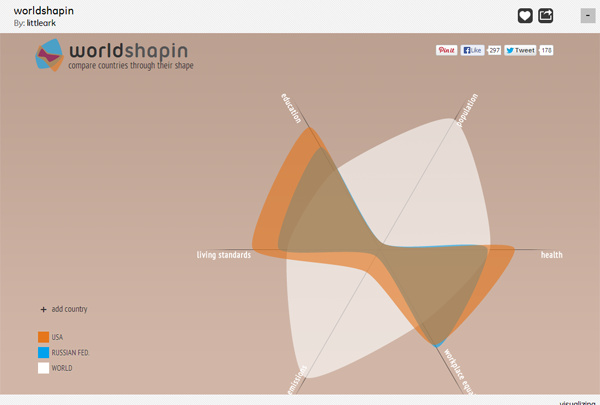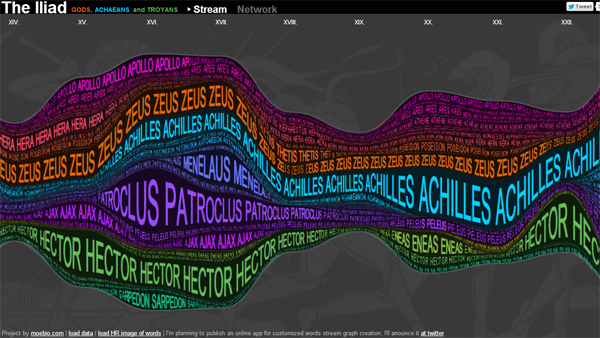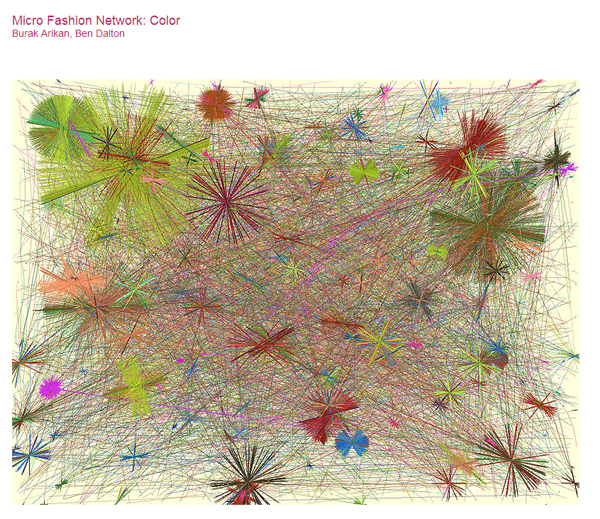10 examples of data visualization
The regular search for information on the Internet is gradually becoming second nature. The new generation is already losing the ability to learn in some other way. This entails the need to organize the most rapid and efficient provision of information to users.
Designers who visualize a large amount of data have two important tasks. First, you need to segment the data so that the principles of use are intuitive. Secondly, it would be nice to make the design so interesting that it is remembered, and made users return to the resource again and again. Visarton
Teamcollected 10 examples of how to organize a large amount of analytical data, while prompting the rules for its use, without tediousness and unnecessary instructions.
So:
1 - The Macrometeorites site talks about the largest meteorites that have ever fallen to Earth. On a gray background, a map is shown on which meteorites are indicated by bright yellow and orange circles. By clicking on the circle of interest, you will go to the page with detailed information about this meteorite.

2 - The Wind Map is an incredible resource that real-time displays wind speed and direction. True, he does this only in the United States. This method of displaying data does not look overloaded or difficult to read through the use of a monochrome color scheme.

3 - Worldshapin this resource allows you to compare the level of health, carbon footprint, level of employment, population and living standards in different countries. The visual design is unusual, but at the same time simple and straightforward.

4 - Any high school student had difficulty trying to decipher the Illiad Homer. The Iliad helps you understand exactly who each chapter is about. Thanks to the bright markers for classifying each hero, you can easily trace their appearance in the poem and immediately find the right place in the text.

5 - Speaking of gay rights, special care must always be taken. The presented scheme democratically shows in which states of America they have, or not, special rights.

6 - Audiomap is a great site for finding new music, choosing the direction you want, and moving from one artist to another. Just select an artist and click on an extension to see similar options. Thus, you can stumble on recordings of those times when your favorite artist sang in a long-forgotten band, or on a song that you have not heard before.

7 - Micro Fashion Network: Color - data on the most popular colors collected in Cambridge are an artwork in themselves. Using a fixed camera and shooting surrounding reality, the designer created a comprehensive network of interconnected colors.

8 - Collecting information about emotions from all over the Internet, We Feel Fine have combined more than 15,000 web emotions that can be sorted by demographics. By choosing one of the brightest points on a black background, the user will be able to find out what others are saying about this emotion.

9 - Yearlight Calendar shows the time of day in your area (dawn, day, twilight, sunset) for each day of the year.

10 - Liveplasma has created an interesting resource for finding artists, books and films. By entering a query, you will find not only the work you were looking for, but also all the related projects (with the same actor, or similar in style).

Designers who visualize a large amount of data have two important tasks. First, you need to segment the data so that the principles of use are intuitive. Secondly, it would be nice to make the design so interesting that it is remembered, and made users return to the resource again and again. Visarton
Teamcollected 10 examples of how to organize a large amount of analytical data, while prompting the rules for its use, without tediousness and unnecessary instructions.
So:
1 - The Macrometeorites site talks about the largest meteorites that have ever fallen to Earth. On a gray background, a map is shown on which meteorites are indicated by bright yellow and orange circles. By clicking on the circle of interest, you will go to the page with detailed information about this meteorite.

2 - The Wind Map is an incredible resource that real-time displays wind speed and direction. True, he does this only in the United States. This method of displaying data does not look overloaded or difficult to read through the use of a monochrome color scheme.

3 - Worldshapin this resource allows you to compare the level of health, carbon footprint, level of employment, population and living standards in different countries. The visual design is unusual, but at the same time simple and straightforward.

4 - Any high school student had difficulty trying to decipher the Illiad Homer. The Iliad helps you understand exactly who each chapter is about. Thanks to the bright markers for classifying each hero, you can easily trace their appearance in the poem and immediately find the right place in the text.

5 - Speaking of gay rights, special care must always be taken. The presented scheme democratically shows in which states of America they have, or not, special rights.

6 - Audiomap is a great site for finding new music, choosing the direction you want, and moving from one artist to another. Just select an artist and click on an extension to see similar options. Thus, you can stumble on recordings of those times when your favorite artist sang in a long-forgotten band, or on a song that you have not heard before.

7 - Micro Fashion Network: Color - data on the most popular colors collected in Cambridge are an artwork in themselves. Using a fixed camera and shooting surrounding reality, the designer created a comprehensive network of interconnected colors.

8 - Collecting information about emotions from all over the Internet, We Feel Fine have combined more than 15,000 web emotions that can be sorted by demographics. By choosing one of the brightest points on a black background, the user will be able to find out what others are saying about this emotion.

9 - Yearlight Calendar shows the time of day in your area (dawn, day, twilight, sunset) for each day of the year.

10 - Liveplasma has created an interesting resource for finding artists, books and films. By entering a query, you will find not only the work you were looking for, but also all the related projects (with the same actor, or similar in style).

